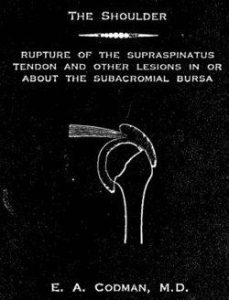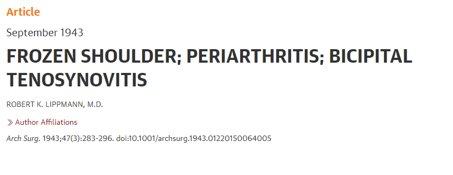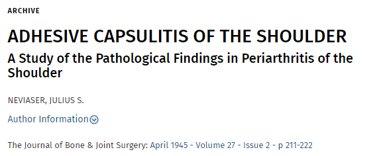It is likely that in your life, you have met or known someone who has suffered from frozen shoulder. It can be an incredible painful condition that is characterised by worsening stiffness, particularly when attempting to move your hand out to your side, behind the back or overhead.
Frozen shoulder can be a difficult condition for practitioners to treat, especially if not well understood. I find that in order to truly understand a condition, we need to know the history of what we once thought caused it and what we used to do to treat it.
What is Frozen Shoulder?

Frozen shoulder was first described in 1896 by orthopaedic surgeon Simon Duplay. He named condition peri-arthritis scapulo-humerale, a term that was used frequently in the literature during the first half of the 20th Century. Duplay posed that the restriction in movement and high pain levels that characterise the condition were caused by inflammation of the sub-acromial bursa that then adhered to ball of the shoulder joint.

The term ’Frozen Shoulder’ was first used in 1934 by famous shoulder physician Ernest Codman. He initially proposed that the condition was caused by a sub-acromial bursitis that adhered to the shoulder capsule, but rejected this in favour for an adherent rotator cuff tendinitis. Codman’s treatment of choice for the condition was to admit his patients to hospital and constrain their arm in maximal elevation. They were only let free from the restraint twice daily to complete pendular exercises. One-hundred percent of Codman’s patients self-discharged from treatment. Codman is famous for his quote ’frozen shoulder is difficult to diagnose, difficult to define and difficult to treat. Almost 100 years later, frozen shoulder can still be a clinical enigma, though our understanding of the condition has vastly improved.
Causes of the Frozen Shoulder
In 1943 Robert Lipman again proposed that frozen shoulder was as a result of biceps tenosynovitis that adhered to the bicipital groove causing pain and restriction of motion. He based his aetiology from a case series of ten patients n which he performed an arthroscopy. We know now that tendinopathy of the long head of biceps is commonly a secondary condition to frozen shoulder.

Soon after, based on a case series of 1945 patients 1945, Julius Nevasier proposed that the shoulder capsule was becoming inflamed and was adhering to the humeral head. This is when the name Adhesive Capsulitis was coined. They would liken it to plaster being applied to the skin and becoming adhered, and their treatment of choice was aggressive manipulation. We know now that in frozen shoulder, there are no adhesions and Adhesive Capsulitis is likely an inappropriate name for the condition. What we know now is that frozen shoulder is caused by thickening and contracture of the joint capsule, that decreases the volume of the joint, leading to pain and restriction of movement.
Types of Frozen Shoulder
In 1969, Lungberg was the first to sub-categorise frozen shoulders. He termed primary and secondary frozen shoulder, with primary being associated with idiopathic onset and secondary occurring following trauma, and forced inactivity following trauma. We can now sub-categorise the condition even further, by describing intrinsic, extrinsic and systemic factors that can contribute to frozen shoulder. Intrinsic being those that directly affect the shoulder joint, such as shoulder surgery; extrinsic being factors such as stroke, or general poor lifestyle habits; and systemic factors such as metabolic or inflammatory disease.
In Japan, the condition is known as ‘the 50-year-old shoulder.’ This is a reflection on the average onset of the condition. Frozen shoulder typically occurs at a mean age of 50 + 10 years. It affects females more so than males, will affect the non-dominant arm more often, and has a strong association with diabetes.
Treatment of Frozen Shoulder
Frozen shoulder can be difficult to treat if not well understood. The condition is surrounded by many misnomers that have stemmed from small studies with uncertain inclusion criteria. It is important that you receive an early opinion from a practitioner that specialises in the area to ascertain an early diagnosis and treatment plan.
Final thoughts on Frozen Shoulder
In conclusion, frozen shoulder is a condition that has perplexed the medical community for many years. It can cause significant pain and stiffness, making even simple daily activities a challenge. Over the years, our understanding of this condition has evolved, from early notions of inflammation to more recent insights into the thickening and contracture of the joint capsule. Despite the complexities of frozen shoulder, there is hope for those who suffer from it. Sub-categorization and a better grasp of intrinsic, extrinsic, and systemic factors have enhanced our ability to diagnose and treat the condition more effectively. Seeking early consultation with a specialist in this field is crucial to ensure a prompt and accurate diagnosis, leading to a tailored treatment plan that can alleviate the pain and discomfort associated with frozen shoulder.
We understand the nuances of frozen shoulder and are here to guide you towards a path of recovery, offering you the support and expertise you need to regain mobility and alleviate the discomfort. Contact Action Rehab Hand Therapy today and take the first step towards a life free from the constraints of frozen shoulder.
—
References
Abrassart, S., Kolo, F., Piotton, S., Chih-Hao Chiu, J., Stirling, P., Hoffmeyer, P., & Lädermann, A. (2020). ‘Frozen shoulder’ is ill-defined. How can it be described better?. EFORT open reviews, 5(5), 273–279. https://doi.org/10.1302/2058-5241.5.190032
Codman, E. A. (1934). The shoulder rupture of the supraspinatus tendon and other lesions in or about the subacromial bursa.
Diong, J., Carden, P. C., O’Sullivan, K., Sherrington, C., & Reed, D. S. (2022). Eccentric exercise improves joint flexibility in adults: A systematic review update and meta-analysis. Musculoskeletal Science and Practice, 102556.
Duplay, E. S. (1872). De la periarthritis scapulohumerale et des radieurs de l’epaule quien son la consequence. Arch Gen Med, 20, 513-542.
Hand, C., Clipsham, K., Rees, J. L., & Carr, A. J. (2008). Long-term outcome of frozen shoulder. Journal of shoulder and elbow surgery, 17(2), 231-236.
Hollmann, L., Halaki, M., Kamper, S. J., Haber, M., & Ginn, K. A. (2018). Does muscle guarding play a role in range of motion loss in patients with frozen shoulder?. Musculoskeletal Science and Practice, 37, 64-68.
Grey, R. G. (1978). The natural history of” idiopathic” frozen shoulder. JBJS, 60(4), 564.
Jones, S., Hanchard, N., Hamilton, S., & Rangan, A. (2013). A qualitative study of patients’ perceptions and priorities when living with primary frozen shoulder. BMJ open, 3(9), e003452.
Lewis, J. (2015). Frozen shoulder contracture syndrome–Aetiology, diagnosis and management. Manual therapy, 20(1), 2-9.
Neviaser, J. S. (1945). Adhesive capsulitis of the shoulder: a study of the pathological findings in periarthritis of the shoulder. JBJS, 27(2), 211-222.
Rangan, A., Brealey, S. D., Keding, A., Corbacho, B., Northgraves, M., Kottam, L., … & Venateswaran, B. (2020). Management of adults with primary frozen shoulder in secondary care (UK FROST): a multicentre, pragmatic, three-arm, superiority randomised clinical trial. The Lancet, 396(10256), 977-989.
Vermeulen, H. M., Rozing, P. M., Obermann, W. R., Le Cessie, S., & Vliet Vlieland, T. P. (2006). Comparison of high-grade and low-grade mobilization techniques in the management of adhesive capsulitis of the shoulder: randomized controlled trial. Physical therapy, 86(3), 355-368.
Wang, K., Ho, V., Hunter-Smith, D. J., Beh, P. S., Smith, K. M., & Weber, A. B. (2013). Risk factors in idiopathic adhesive capsulitis: a case control study. Journal of shoulder and elbow surgery, 22(7), e24-e29.
Whelton, C., & Peach, C. A. (2018). Review of diabetic frozen shoulder. European Journal of Orthopaedic Surgery & Traumatology, 28(3), 363-371.




















